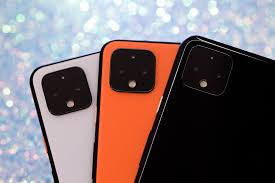Google Pixel 4 and Pixel 4 XL
Google has introduced the Google Pixel 4 and 4XL with 90 Hz screen and dual cameras. The screen between these two smartphones is the only thing that makes them both different. Google Pixel 4 has a 5.7-inch OLED display with 1080p + resolution. The XL model size is 6.3 inches and the resolution is Q-HD Plus. The aspect ratio of both displays is 19: 9. Both the screen has no scratches to complicate the layout of the user interface.
Both of these smartphones have a new Smooth Display that enables a 90Hz refresh rate. To save battery, the display also shifts to a 60 Hz refresh rate but this happens when the phone is not doing anything special. - The phone screen supports HDR and Always On.
The phone also has a new Ambient EQ that monitors the ambient light and displays the display color accordingly.
The Pixel 4XL also has the same camera as the Pixel 4. The main camera of the phone is 12 megapixel with dual pixel autofocus, f / 1.7 bright aperture, and 1.4µm pixel lens size. However, it does not have sensors, lenses or hardware, but the new Pixel Neural Core and Google's proprietary algorithm optimize image quality.
The new Pixel Neural Core can be rendered in real-time by the Camera app HDR Plus.
This viewfinder looks almost like a final result. This will help adjust the exposure. Dual exposure controls give users manual control over shadow and light rendering. In the dark, its new nightclub feature can picture up to 15s of exposure.
Telephoto cameras are also new in the Pixel brand. It supports 16-megapixel sensors (1.0µm) with OIS and EIS.
Its focal length is not double the regular camera, but the super-resolution zoom software can more than double its zoom.
The Fu's main camera can record video at 4K 30fps. It can record at 1090p in 120fps solution. There is also a third module on the back of the phone but it is not a camera but it is a spectral and flicker sensor. The Pixel 4 phone does not have an ultrawide camera.
Even though it was present in Pixel 3.
The Pixel 4 selfie camera is 8 megapixels. What makes it special is its 3D depth sensor. This fee will be unlocked and used for selfies. There is no fingerprint reader anywhere on the phone. Another highlight on this phone's display is the Soli radar. This is for monitoring the movements of the hands. It will be disabled in many countries, such as Japan.
The battery capacity of the Pixel 4 and 4XL is also different. The Pixel 4's battery capacity is 2800mAh and the Pixel 4XL's battery capacity is 3700mAh. Both smartphones' batteries support 18W USB power delivery fast charging. You can also use the Qi wireless charger to charge the phone. It activates Ambient Mode.
Both smartphones have Snapdragon 855 (non-plus) chipsets, 6GB RAM and 64GB or 128GB internal storage. Unfortunately, the microSD card is not supported to increase phone storage. The phone also has e-SIM support along with Nano-SIM. Aluminum frames also have glass on the back of these smartphones. The phones will be available in Just Black, Clearly White and the new Oh So Orange colors.
These phones are IP68 certified for water protection. Delivery of Pixel 4 phones to the US and Taiwan will begin on October 22, October 28 in Europe and October 21 in Australia and Canada. The 64GB version of the Pixel 4 starts at $ 800 and the 64GB version of the Pixel 4XL starts at $ 900. You will pay an additional $ 100 if you purchase an upgraded version of the storage.



Post a Comment
The latest Google phones are the best the company has produced yet, with plenty of power, slick software, and awesome cameras, but which one should you go for? Is the regular Pixel 4 the best option or should you go large with the Pixel 4 XL. We’re here to help with a detailed breakdown of the differences between these two phones, so read on to find out exactly how the Pixel 4 and Pixel 4 XL measure up.